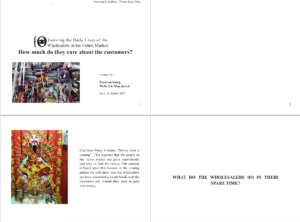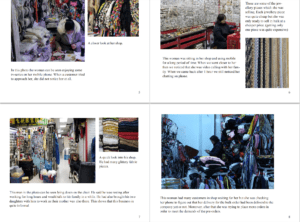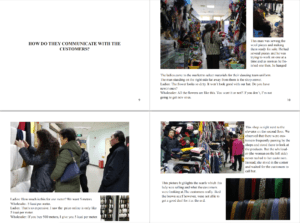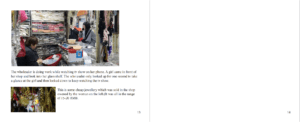Idea evolution: My initial idea for the final project was to research if fashion exchange works for fashion industry. My goal was to think about a complete online clothing exchange system that helps people exchange their clothes. After researching this idea further, I realized a lot of similar services already exists and so I decided to change my focus to a more hands-on project, something I have wanted to do from the beginning.
My first thought was to make wearable textile by re-using plastic and other materials that I and friends would discard in our daily life. Upon researching this idea further, I came to another realization. What I wanted to do is called “trash fashion” and is not “sustainable fashion.”
To get more inspiration, I went to the Intertextile Exhibition last Thursday and re-watched The Next Black. This time, what caught my attention was the idea of reusing and redesigning clothes. One way to make clothes sustainable is to produce it in a way that makes it easy to reuse parts of it for new designs. I won’t engage in my own production (yet, perhaps) but can still demonstrate the principle of repurposing clothes.
A lot of time, we see our clothes as having one specific purpose, but we ignore their most basic attribute – they are made up of fabrics. Rather than just thinking of what we can do with our old clothes or who else could wear them, we should see not the whole and assign a purpose to it but see it as a collection of fabric and we should ask ‘What can we do with these fabrics?’
Problem identified:
When talking about sustainability, people like to put blame on unethical brands and factories, but we seldom change much about ourselves or do much. For instance, when we are dealing with our old clothes, we usually choose to throw them away or sell them. However, clothes is made of fabrics that can be reused and recycled in many ways to make them sustainable.
Research update:
When I began researching my idea of repurposing clothes online, I was unexpectedly reminded of an important figure in my life: my mom. Of all the people I know, she is the one who has the most ‘sustainable’ approach to clothes. Throughout my life, she has recycled, reused and repurposed almost all her clothes and magically made it into something else.
For example, if a jacket is broken but the zipper is fine, she will simply cut free the zipper and use it on clothes where the zipper is broken. She also likes to collect leftover fabrics and make small accessories like sleeve protectors, hats, coin purses and cup coves, etc. At the very beginning, when she started doing this, she was just trying to save money. Now, it has become a lifestyle. She keeps making all those things by herself and I found she appreciates them more.
Websites I have consulted
http://trashisfortossers.com/how-to-recycle-old-clothing/
https://www.thebalancesmb.com/how-garment-recycling-works-2877992
https://www.lifehack.org/453113/27-creative-ways-to-reuse-old-clothing
Asset Development:
I originally collected a lot of plastic and resources for my previous idea that, ironically, I now have to find a new purpose for. But for my new project of reusing clothes, I have had my parents send me my old clothes from my hometown in Anhui. When it arrives in Shanghai, I will begin my process of restoring it from an article of clothing with a purpose to individual pieces of fabrics useful for any textile purpose.



